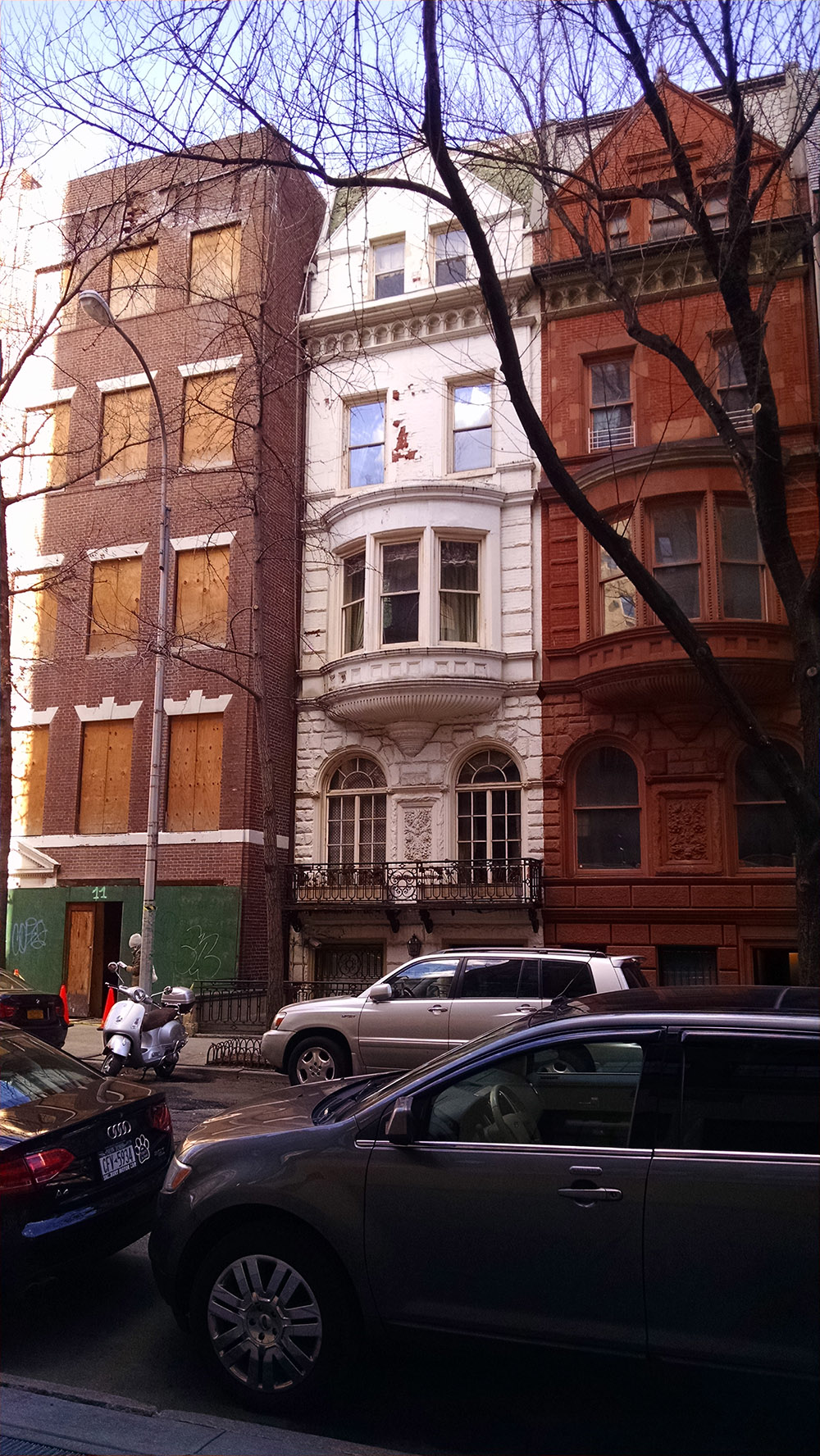Building Name
11-15 75th Street
Architect
William E. Mowbray
Year(s) Built
1887-89
Designation
Upper East Side Historic District

Project Information:
Two Queen Anne style rowhouses designed by William E. Mowbray and built in 1887-89; and one rowhouse originally built in the Queene Anne style in 1887-89 and redesigned in the neo-Federal style by Henry Polhemus in 1923. Application is to replace the front facade of 11 East 75th Street; and alter the areaway and rear facades, remove party walls, construct rooftop additions, excavate the cellar and create green walls in the rear yard at all three houses.
CB8 Hearing: 03/14/16 (Front facade and rooftop addition – Approved; Rear elevation and green walls – Disapproved)
LPC Hearing: 03/15/16 (Laid Over); 04/05/16 (No Action)
LPC Meeting: 06/14/16 (Approved)
FRIENDS' Testimony:
The Preservation Committee at FRIENDS believes that overall, this project is inappropriate and that the proposed removal of the façade at Number 11 raises philosophical questions about how to approach preservation. By allowing the demolition of the facade at 11 East 75th Street, the Commission would discredit an almost 100 year-old contributing element to the Upper East Side Historic District. It is imperative to note that in the designation report, the building is listed as a Neo-Federal style building.
Because the Queen Anne style is rare on the Upper East Side, some members of our Committee felt that a return to this style at Number 11 would be a noble attempt to assert a more unified stylistic impact on the streetscape. Yet, this whole design rests on only a small sliver of a photograph showing the original Queen Anne facade. By demolishing the current façade, the history of the building will be misrepresented. Although it would be nice to paint a pretty picture by attempting to recreate this façade, this action would erase a significant piece of history.
Furthermore, the removal of the Neo-Federal façade makes the statement that one historic style is preferable over another. The existing 1923 façade speaks to an important moment in architecture when the remodeling of rowhouses was avant-garde, and the preservation of this façade is crucial to the history of the Upper East Side’s architecture and development. In 2012, the Commission approved plans for the restoration of this façade to improve its stately Neo-Federal appearance, which FRIENDS supported, and we feel that the spirit of these previously approved plans should be upheld in this new application. The prior owner of the building began to strip its architectural details, but never completed the approved restoration, thus leaving the building in disrepair. The current owner should not be allowed to completely scrap this building’s façade simply because its restoration plans were never carried out.
Aside from the removal of the façade at Number 11, the proposal includes a number of other problematic details. The rear elevation is far too industrial in appearance, and is aesthetically inappropriate as the secondary elevation of a residential building. We feel that the rear should look like a traditional secondary elevation, typically with punched openings and masonry walls. Another problematic element is the reconfiguration of the entrances along the street. The proposal seeks to maintain the appearance of three separate houses, but the plan to have a main basement-level entry in the middle and a secondary entrance atop the stoop fundamentally alters the relationship between these buildings and the street.
Overall, FRIENDS does not support this project. We insist that the 1923 Neo-Federal façade be retained. Its demolition would set the precedent that it is acceptable to allow for a contributing façade to be replaced entirely, simply because the former owner abandoned its restoration and allowed the building to deteriorate. We urge the Commission to deny this application in order to protect against the creation of an artificial history.
LPC Hearing:
FRIENDS' Testimony:
FRIENDS is pleased to see that the Neo-Federal style facade of Number 11 has been incorporated into the new designs for this project. In our last testimony, we stated that the demolition of a “style” facade in the Upper East Side Historic District was inappropriate, and its replacement with a faux Queen Anne building would create a false sense of history. After testimony against the demolition of Number 11 from FRIENDS and others, such as the Historic Districts Council and Andrew Dolkart, we are happy that our comments were heard and acknowledged in this new design. We appreciate that the evolution of this group of buildings will be preserved and not erased.
Although the Commission approved changes to the facade of Number 11 in 2012, which included the relocation of the entry and the addition of a limestone base, the architect has chosen not to follow a similar design path. Instead, the design will remain true to the building’s original design. FRIENDS applauds this decision. Although the cornice will not be replaced in wood, the limestone-colored cast stone cornice and other details will be fitting to the Neo-Federal style.
At Numbers 13 and 15, the reconfiguration of the base is problematic. The wide abstract metal door at Number 13 is too institutional, and does not relate to the building or its neighbors. While we appreciate the revision of the design to include three entrances – which helps to define these buildings as three individual homes – we regret the loss of the stoops, and ideally would like to see them restored. In addition, FRIENDS feels that the proposed iron fence running along these three buildings is too tall. Unlike the tall fence at 3 East 75th Street, which is historic and relates to the large proportions of the building, this proposed fence is not rooted in the original design of this group of buildings. Because the entrances to Numbers 13 and 15 are below sidewalk level, the fence will overwhelm these recessed buildings.
At the rear, the excessive glazing is jarring and resembles a Midtown office, rather than a residential building. A traditional masonry rear elevation would be more appropriate for this block. Overall, FRIENDS supports the preservation and restoration of the facade of Number 11, but we ask the Commission to work with the architect to create a more contextual design for the front entries and rear elevation.

